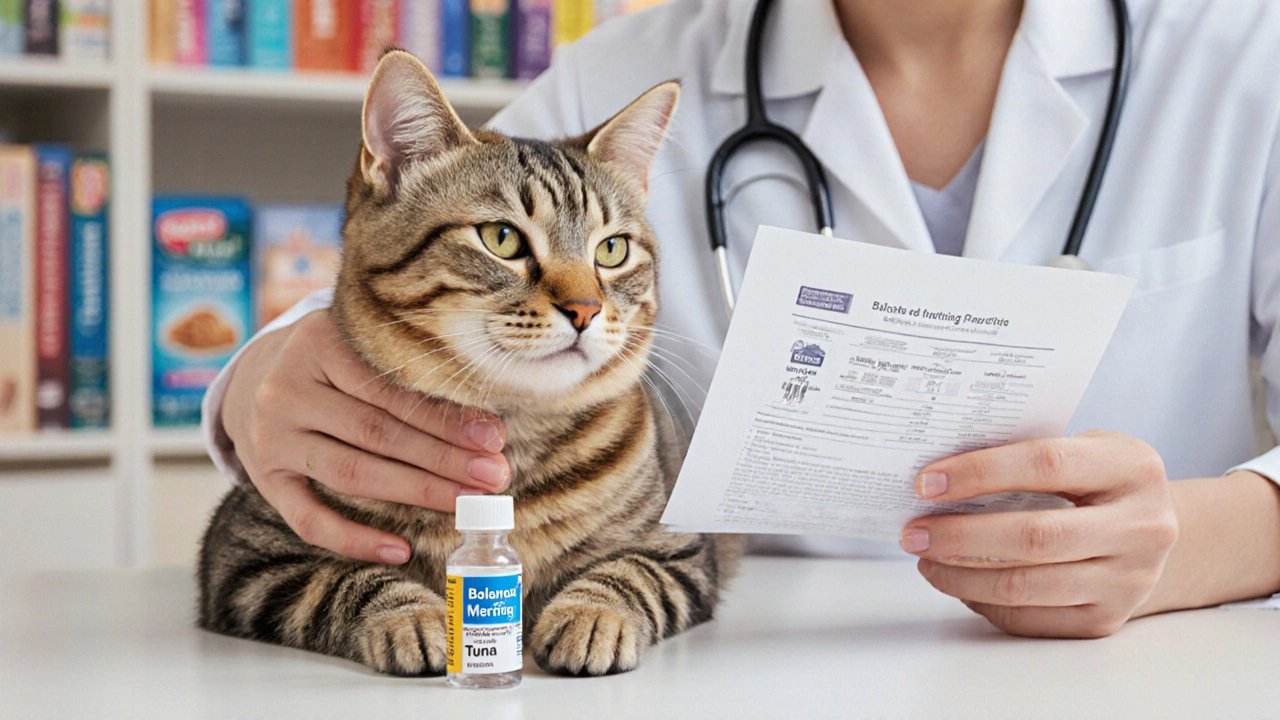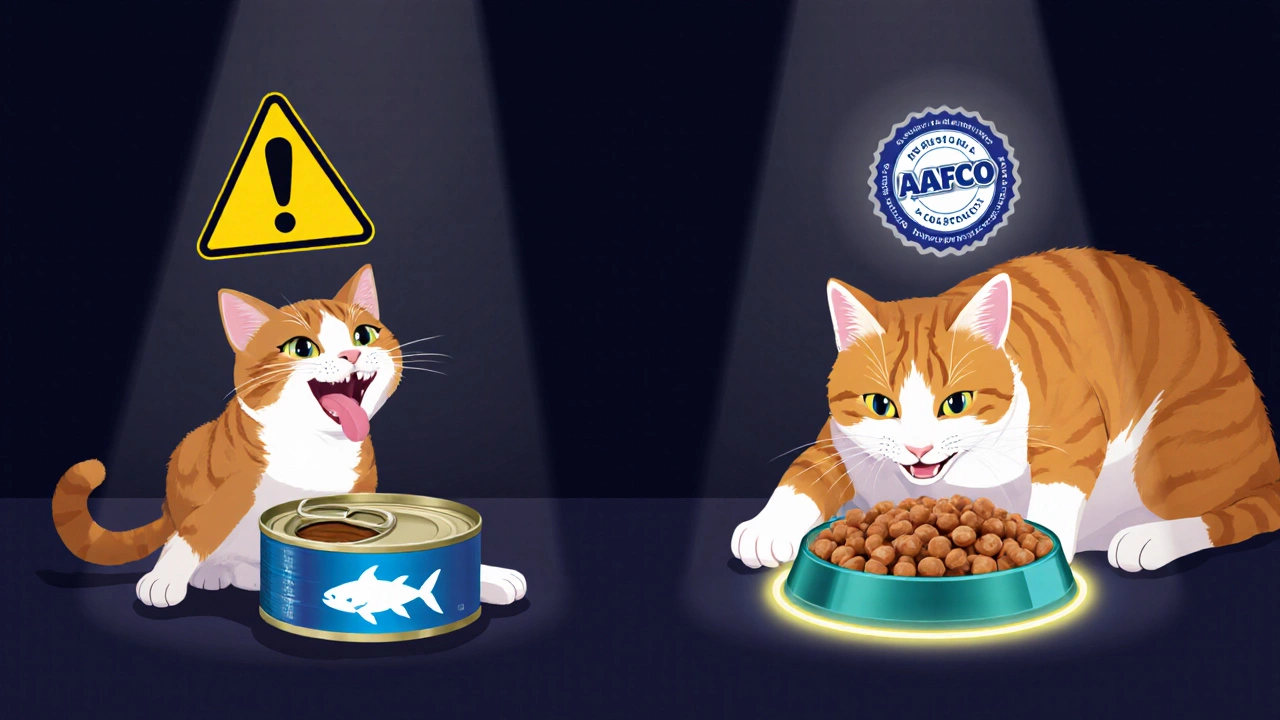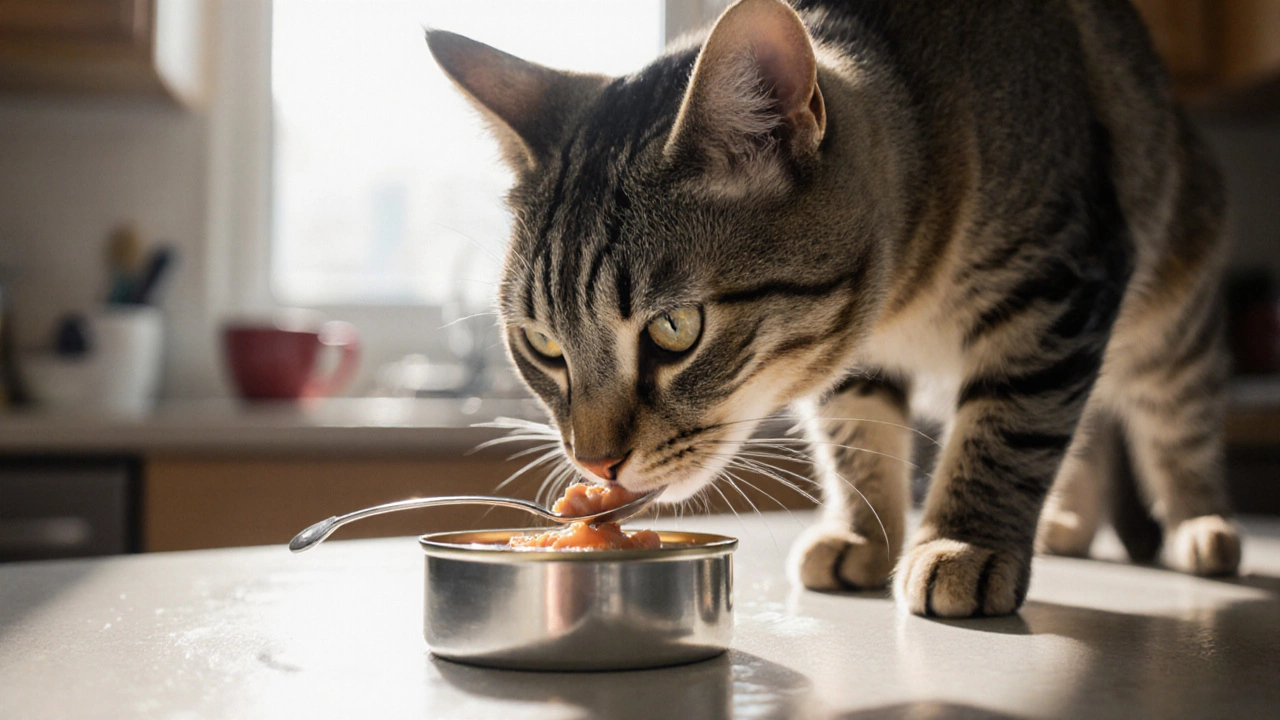Many cat owners reach for a can of tuna when their cat begs for a treat. It’s cheap, easy, and your cat goes crazy for it. But is tuna actually good for cats? The short answer: occasional small amounts, yes. Daily meals, no.
Why Cats Love Tuna
Cats are obligate carnivores. That means their bodies are built to thrive on meat - especially meat rich in animal protein and fat. Tuna fits that profile. It’s packed with protein, has a strong smell, and a soft texture that’s easy for cats to chew. That’s why even a picky eater will lick the can clean.
But liking something doesn’t mean it’s healthy. Think of it like candy for kids. Your cat loves it, but too much can cause real problems.
The Risks of Feeding Tuna Too Often
Feeding your cat tuna every day can lead to serious health issues. Here’s what happens:
- Mercury poisoning - Tuna, especially albacore and bigeye, contains high levels of mercury. Cats are small, so even tiny amounts build up over time. A 2023 study from the University of Melbourne found that cats fed tuna daily for over six months showed elevated mercury levels in their blood - enough to affect kidney and nervous system function.
- Thiamine deficiency - Raw or canned tuna contains an enzyme that breaks down thiamine (vitamin B1). Without enough thiamine, cats develop neurological problems: seizures, loss of balance, even coma. This isn’t rare. Vets in New Zealand report 3-5 cases a year from owners who think tuna is a healthy daily snack.
- Nutritional imbalance - Tuna lacks taurine, arginine, calcium, and other essential nutrients cats need. Feeding it as a main meal means your cat misses out on the full spectrum of nutrients found in properly formulated cat food.
- Obesity and pancreatitis - Tuna is high in fat. Regularly feeding it can lead to weight gain and inflammation of the pancreas, which causes vomiting, pain, and long-term digestive issues.
What About Canned Tuna in Water?
Some people think switching to tuna packed in water makes it safe. It helps - but not enough.
Tuna in water has less oil and salt than tuna in brine or oil, so it’s a slightly better choice. But it doesn’t fix the mercury, thiamine, or nutrient issues. Even the "light tuna" labeled as "safe for humans" still contains enough mercury to be risky for cats over time.
Also, watch out for added ingredients. Some canned tuna has garlic, onion powder, or spices. Those are toxic to cats. Always check the label - and if it’s not just tuna and water, don’t feed it.

How Much Tuna Is Safe?
If you want to give tuna as a treat, here’s the safe rule:
- Once a week, max.
- One teaspoon of tuna (about the size of a pea) is enough for a 10-pound cat.
- Never use tuna to replace a full meal.
- Never give raw tuna - it carries bacteria and parasites that can make cats very sick.
Think of tuna like dessert. You wouldn’t let your kid eat ice cream for breakfast, lunch, and dinner. Same for your cat.
What Should Your Cat Be Eating Instead?
Cats need a diet that’s balanced for their biology. Look for cat food that says:
- AAFCO-approved - This means it meets nutritional standards set by the Association of American Feed Control Officials.
- High in animal protein - The first ingredient should be meat, like chicken, turkey, or fish (not fish meal or by-products).
- Contains taurine - This amino acid is critical for heart and eye health. All quality cat food includes it.
- No fillers - Avoid foods with corn, wheat, or soy as main ingredients.
There are also cat foods made with fish - like salmon or sardines - that are formulated to be safe and balanced. These are a better way to give your cat the taste of fish without the risks.

Signs Your Cat Has Had Too Much Tuna
If your cat has been eating tuna regularly, watch for these warning signs:
- Loss of appetite
- Vomiting or diarrhea
- Lethargy or weakness
- Loss of coordination (stumbling, wobbling)
- Seizures or tremors
If you see any of these, stop feeding tuna immediately and call your vet. Thiamine deficiency and mercury poisoning can be reversed if caught early - but they get worse fast.
Alternatives to Tuna That Cats Love
Want to give your cat a tasty treat without the risks? Try these instead:
- Small pieces of cooked chicken or turkey - No seasoning, no bones.
- Freeze-dried meat treats - Made from chicken, beef, or fish, and nutritionally balanced.
- Specialty cat treats with salmon or sardines - These are made for cats, not humans, and are fortified with vitamins.
- Cat grass or catnip - Not food, but many cats enjoy the taste and it’s completely safe.
These options give your cat variety and excitement without the hidden dangers of tuna.
Final Verdict
Tuna isn’t poison - but it’s not food. It’s a treat, plain and simple. Giving your cat tuna once a week in tiny amounts won’t hurt. But making it a regular part of their diet? That’s asking for trouble.
Your cat’s body needs consistent, balanced nutrition. That comes from food made for cats - not from what’s on your dinner plate. The tuna your cat loves so much is like feeding them cake every day. It tastes great, but it’s not what they need to live a long, healthy life.
Can kittens eat tuna?
No. Kittens have even more sensitive digestive systems and higher nutritional needs for growth. Tuna lacks the balanced nutrients they require and can cause thiamine deficiency or mercury buildup faster than in adult cats. Stick to kitten-specific food until they’re at least one year old.
Is raw tuna safe for cats?
No. Raw tuna can carry harmful bacteria like Salmonella and Listeria, and parasites like tapeworms. Cats can get seriously ill from these. Even if the tuna looks fresh, it’s not safe for raw feeding. Always cook it thoroughly if you’re offering it as a rare treat.
Can cats be allergic to tuna?
Yes. Some cats develop food allergies to fish, including tuna. Signs include itchy skin, ear infections, vomiting, or diarrhea. If your cat shows these symptoms after eating tuna, stop feeding it and talk to your vet. A food elimination trial can confirm the allergy.
Does tuna cause kidney problems in cats?
Not directly, but the mercury and phosphorus in tuna can stress the kidneys over time. Cats are prone to chronic kidney disease as they age, and feeding them high-mercury foods like tuna adds unnecessary strain. A balanced diet with controlled phosphorus levels is far better for long-term kidney health.
What’s better: canned tuna or wet cat food with fish?
Wet cat food with fish is always better. It’s formulated to meet your cat’s nutritional needs, with the right balance of protein, taurine, vitamins, and minerals. Canned tuna for humans is not - it’s made for people, not cats. Even the best fish-based cat food has lower mercury levels and added nutrients that tuna lacks.
